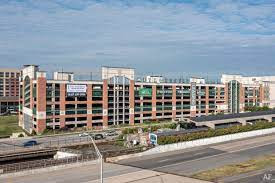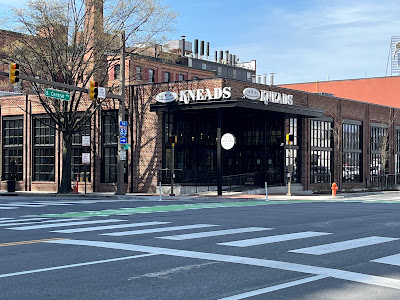A panel discussion organized by the Baltimore Business Journal with the topic Moving Greater Baltimore Forward with Transit Oriented Development (TOD) brought into stark focus that the concept is still mostly just an aspiration in this region, especially in Baltimore County where the panel took place.
 |
| BBJ TOD discussion panel |
BBJ editor Rhonda Pringle interviewed developer Mark Renbaum before the panel discussion to set the stage. He proposes a mixed use project to replace an ailing shopping center along a three decades old rail transit line. But instead of jubilation about an actual transit oriented development that isn't asking first for public money before making an investment which replaces decay and stagnation, there is hemming and hoeing and no movement. The project is hung up with an uncertain future that is largely depending on political decisions that are yet to be made. (See previous article here). The location, in Baltimore County, sits on land that is zoned commercial, a category which doesn't allow real TOD since it excludes residential use. The term TOD is still not part of the County's zoning toolbox, even though transit rail stations are part of the County's landscape for more than 40 years. The current draft 2030 Masterplan which otherwise is a pretty innovative and courageous document mentions TOD as a goal in a short paragraph, not what is needed to lift the project across the hurdles in Lutherville.
The maybe most prominent participant expected for the discussion panel and advertised as visionary was developer Howard Brown. Brown is the "father" of the only County TOD in place, the Owings Mills Metro Center. Other than Owings Mills he completed a rail oriented project at Symphony Center in the City and has been promising another TOD at Charles and Baltimore Streets for 15 years, but so far all there is to see is a hole where the Mechanic Theatre once stood. However, Brown was a no-show and had his grandson David Adler sit in for him. The panel also also included MDOT Real Estate Director Nimisha Sharma, County Council Chair Julian Jones and the new CEO of the Greater Baltimore Committee Mark Anthony Thomas and me.
 |
| Metro Center: Isolated from Owings Mills neighborhoods |
The Owings Metro Center, the county's TOD flagship is a public private partnership between County, State and David S. Brown Enterprises that has been in the making for decades and resulted in a mixed use center that includes 350 apartments, a Marriott hotel, retail, and a branch of the Baltimore County Community College and the County library system and which is slated to expand to the other side of the Interstate 795 in the next few months. All partners describe the project as complex and difficult. When Brown started Metro Center most developers were still specialized in just one thing, offices, apartments or retail. True mixed use was still somewhat a novelty, at least in our region. For David Adler, mixed use is naturally what he wants to do. However, asked about the downtown Baltimore lot, Adler was non committal. The company seems to wait for a helping hand from the City.
The new urbanist Metro Center development in Owings Mills suffered from the beginning from the MDOT requirement that all surface park and ride parking spaces then on MDOT owned land had to be replaced in a giant multistory parking garage at an enormous cost, mostly shouldered by the public. The already unfortunate position of the Owings Mills Metro station in the median of an Interstate became even more unfortunate by the mammoth garage which blocks the view of the new town center. As I desribed in an earlier article, Metro Center is further hampered by the nearby redevelopments of the former mall and the Solo Cup area, both also supported by the County. But both developments are isolated from Metro Center and as a result are their own destinations, siphoning energy away instead of being synergistic with the concept of an Owings Mills town center.
 |
| Metro station in the median with giant parking garage blocking the view of the TOD |
In short, neither Metro Center as Baltimore County's flagship TOD nor Owings Mills as an envisioned new town with a center are quite on par with flourishing TODs on the Virginia side of Washington's Metro system or with the continually evolving Columbia Town Center. Many area residents prefer to go there instead of Owings Mills. This situation represents an excellent opportunity to catch up with additional TODs such as Lutherville, on land next to an existing light rail station and bus terminus. However, a recommendation to designate the station as TOD under state provisions is lingering for months at the Planning Department. Another opportunity is the ailing Security Square Mall, located right where the east west transit "Red Line" would have ended. This line has become more likely again with the new Governor Moore. A large TOD would boost the chances for this additional transit line to become a reality. Although the mall is already served by two bus lines currently ending on the mall, transit isn't identified at all on a rendering for the redeveloped mall that is included in the draft masterplan 2030. On the panel everyone agreed, that mixed use around transit stations is the way to go in a time where open land for development is scarce and should be protected.
The Governor, meanwhile, has appointed Joe McAndrew as a Assitant Secretary with a focus on TOD statewide. McAndrew with a Masters in regional planning understands that the first order of business has to be making best use of existing transit assets by using the land around stations as intensely as possible by putting dense "transit supportive" development there. This means uses that represent attractive "origins or destinations for transit riders", i.e. places where transit users would start or end a trip, ideally seven days a week and during most hours, not just rush hour.
The right use can generate up to 5 riders a day on the same area that a single parking space plus its share of circulation aisles occupies. In other words, parking a car all day at a transit stop for a trip to work is a wasteful use of space, far from being "transit oriented development". Insisting on replacing all surface parking at rail transit stations for continued use as a park and ride facility is, therefore, misguided. Additionally those garages fly in the face of climate change actions: The garages are not only very expensive and waste space, they also produce a lot of CO2 because they are made from concrete, one of the worst CO2 emitters. The garages are also not future proof: Not only do they encourage car usage, they will likely stand empty in a few years when cars will not only be electric but self driving (at least in garages) and hopefully many people will make their car trips in hired, shared vehicles that are rarely parked. Autonomous and shared mobility would reduce the needed space for parking drastically and require very different types of garages since autonomously parked cars would not need 22' wide drive aisles or 9' wide spaces. However, these insights have still not trickled down to the decision makers. Officials announced just this week a new $4 million conventional garage at Odenton, all in the name of TOD!
 |
| TOD viability on the WAMTA system (WAMTA) |
Maryland has 106 rail transit stations, too many of them are still surrounded by parking lots or low density non-walkable uses. Too much development that is touted as TOD is in reality just "transit adjacent" with people driving and parking to the uses as if transit wasn't there at all. The lack of useful places to go via transit is the result of not enough transit and of not enough appropriate development at stations. No single development can solve the problem, no matter how good it is or where it is located. What is needed is a concerted effort that indicates the development potential of all 106 stations and puts the state's growth intentionally where transit is already the most useful. This requires a lot more collaboration between transit providers (MDOT) and local jurisdictions to achieve the optimal transit and land use balance. The result should be a win for transit, for the tax base of local jurisdictions and the quality of life in existing communities.
An example how this works can be seen in WAMTA's strategic TOD metrics and the growing number of stations that deserve the label TOD and represent high quality place-making. It is exactly this type of plan that Maryland needs for all the other stations in order to successfully combat air pollution, traffic congestion, under performing transit and meet its ambitious climate change targets.
Klaus Philipsen, FAIA






.HEIC)




